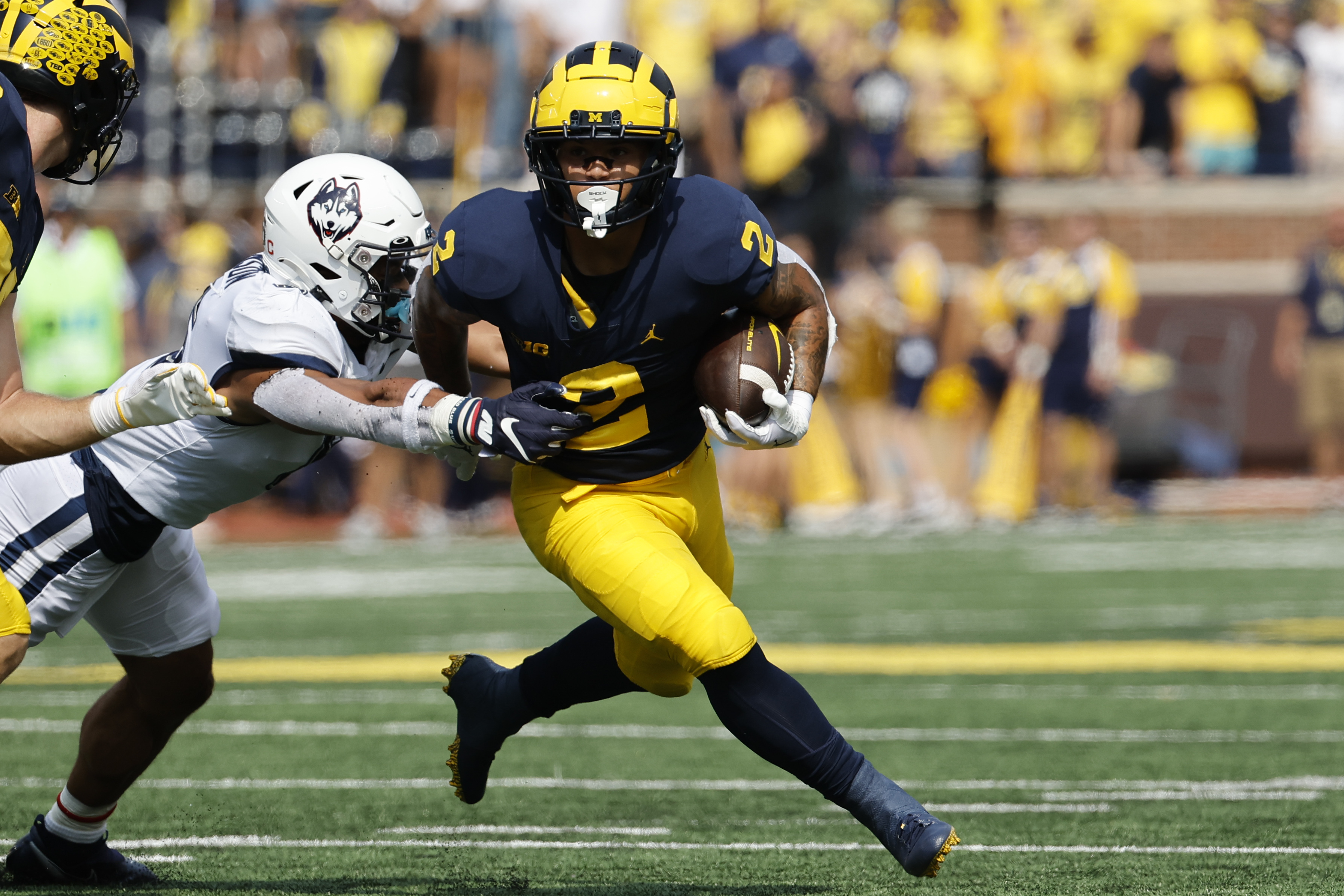Ad Disclosure

Michigan football: Trust Blake Corum to set up wins moving forward, even against Iowa
Michigan finally has a quarterback who isn’t limited with his arm. Sorry to the Cade McNamara truthers out there, but JJ McCarthy’s emergence has ended the conversation on which passer should be QB1 for the remainder of the season.
Of course, as of right now, none of that matters.
Michigan knows its offense can pass when it needs to pass. McCarthy has weapons such as wide receivers Ronnie Bell and Roman Wilson. He also has targets like tight ends Erick All and Luke Schoonmaker who can work the middle of the field.
That’s great. That type of production will be warranted when the Wolverines become a one-dimensional offense by necessity instead of choice.
Until then, Michigan will focus on its run game to carry the load throughout B1G play.
More specifically, the Wolverines will trust running back Blake Corum to be the catalyst of the offense. He’s running toward the best odds to take home the Doak Walker Award in December. Might as well run Michigan back to the postseason.
“I think the really good running backs, the great running backs, a running back like Blake that has that kind of (ability) — I think they crawl out of the crib with it,” Wolverines coach Jim Harbaugh said earlier this week.
Corum has been consistent over the past 2 seasons. His numbers might suggest that 2022 is a breakout campaign for him, but it is more so just trust from Harbaugh in terms of being the lead back. Last season, Corum was forced to split reps with the bulldozing Hassan Haskins, who averaged 4.9 yards per carry and totaled 20 rushing touchdowns.
Initially, that was the plan again this season for Michigan. With Haskins gone to the NFL, the Wolverines ideally wanted to use Corum as the lead back while sprinkling in reps for Donovan Edwards.
Instead, Michigan’s winning formula features copious amounts of designed runs from Corum and a pinch of Edwards. Through 4 games. Corum has totaled 64 rush attempts for 478 yards and 9 touchdowns. Edwards, battling injuries, has recorded 15 carries for 90 yards. Freshman CJ Stokes has tallied 23 carries for 112 yards.
Blake Corum: 8 rushes of 20+ yards
Most in college football😤🔥 pic.twitter.com/dSARDMXQzk
— PFF College (@PFF_College) September 26, 2022
For now, it’s Corum’s team.
He’s the x-factor to the team’s hot offensive production in the post-Josh Gattis era. Of Michigan’s 24 touchdowns, Corum is responsible for nearly 38% with 9 scores.
In Saturday’s 34-27 win over Maryland, Corum totaled 243 yards on 30 carries. Both of his touchdown runs came on plays of over 30 yards, and he had 2 other “explosive runs” of over 20 yards.
The 243 rushing yards were also enough to give Corum B1G Offensive Player of the Week honors and marked the most rushing yards by a Wolverine since Tim Biakabutuka’s 313-yard outing against Ohio State in 1995.
#B1GFootball 𝗖𝗼-𝗢𝗳𝗳𝗲𝗻𝘀𝗶𝘃𝗲 𝗣𝗹𝗮𝘆𝗲𝗿𝘀 𝗼𝗳 𝘁𝗵𝗲 𝗪𝗲𝗲𝗸
🔵 Blake Corum, @UMichFootball
〽️ Tanner Morgan, @GopherFootball
🗞️ More on their accomplishments: https://t.co/1qzdZNq2sF pic.twitter.com/3j235wzyD5
— Big Ten Football (@B1Gfootball) September 26, 2022
Iowa will be a challenge
Saturday at Iowa (noon ET, Fox), Michigan’s ground game will face its first true test of the season. The Hawkeyes’ defense remains one of college football’s finest. More specifically, Iowa’s run defense has been an immovable object at the point of attack, holding opponents to 73 yards per outing.
This might be the time for Harbaugh to cut loose his 5-star quarterback. Given the fact that the Wolverines will have to face opponents soon like Penn State, Michigan State and B1G favorite Ohio State, seeing where McCarthy’s limitations are as a passer isn’t the worst idea.
Then again, let Iowa’s defense force the Wolverines to pass. Who knows? Perhaps inept offensive production from opponents is bolstering Iowa’s street cred as an “elite” run defense.
Currently, the best ground attack the Hawkeyes have faced this season is Rutgers, which ranks 43rd among FBS schools in rushing offense. Meanwhile, Iowa State and Nevada have averaged 133.5 and 133.2 yards per game, placing them in mid-90s.
Blake Corum's burst, elusiveness + stop/start is ridiculous pic.twitter.com/Bv0OfAdoWs
— Connor Rogers (@ConnorJRogers) September 27, 2022
Until the Hawkeyes prove that they can contain Corum, the goal should be for Michigan to pound the rock. So far, 4 defenses have looked to eliminate the 5-foot-8 running back’s production.
All have failed. Iowa might too.
Cole Thompson is a freelance writer for Saturday Tradition who has covered college football and the NFL for multiple websites. Thompson is currently based in Houston, Texas, and also can be heard daily on SportsMap National Radio's 'Just Sayin It' from 3am-6am.